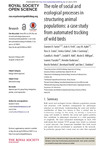The role of social and ecological processes in structuring animal populations
| dc.contributor.author | Farine, Damien R. | en_US |
| dc.contributor.author | Firth, Josh A. | en_US |
| dc.contributor.author | Aplin, Lucy M. | en_US |
| dc.date.accessioned | 2016-10-11T05:37:07Z | |
| dc.date.available | 2016-10-11T05:37:07Z | |
| dc.date.issued | 2015 | en_US |
| dc.identifier.other | HPU4160542 | en_US |
| dc.identifier.uri | https://lib.hpu.edu.vn/handle/123456789/23528 | en_US |
| dc.description.abstract | Both social and ecological factors influence population process and structure, with resultant consequences for phenotypic selection on individuals. Understanding the scale and relative contribution of these two factors is thus a central aim in evolutionary ecology. In this study, we develop a framework using null models to identify the social and spatial patterns that contribute to phenotypic structure in a wild population of songbirds. We used automated technologies to track 1053 individuals that formed 73 737 groups from which we inferred a social network. Our framework identified that both social and spatial drivers contributed to assortment in the network | en_US |
| dc.format.extent | 11 p. | en_US |
| dc.format.mimetype | application/pdf | en_US |
| dc.language.iso | en | en_US |
| dc.subject | Biology | en_US |
| dc.subject | Behaviour | en_US |
| dc.subject | Great tit | en_US |
| dc.subject | Immigration | en_US |
| dc.subject | Paridae | en_US |
| dc.subject | Social organization | en_US |
| dc.title | The role of social and ecological processes in structuring animal populations | en_US |
| dc.type | Article | en_US |
| dc.size | 5.64MB | en_US |
| dc.department | Education | en_US |
Files in this item
This item appears in the following Collection(s)
-
Education [806]

